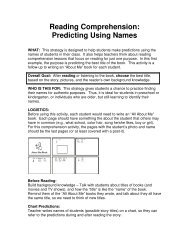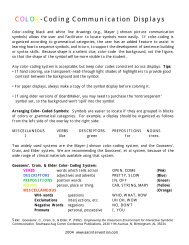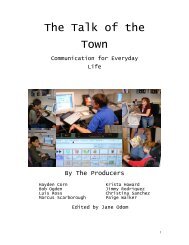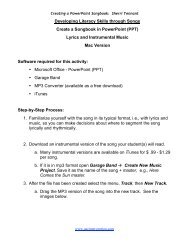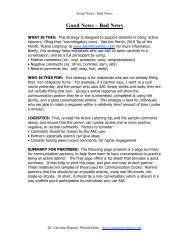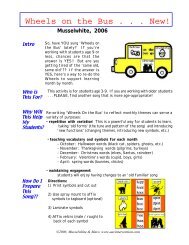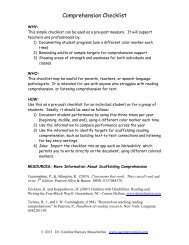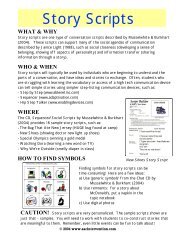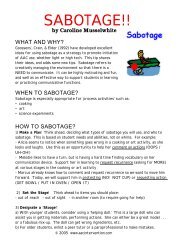Poetry Read Write Spek Listen - AAC Intervention.com
Poetry Read Write Spek Listen - AAC Intervention.com
Poetry Read Write Spek Listen - AAC Intervention.com
Create successful ePaper yourself
Turn your PDF publications into a flip-book with our unique Google optimized e-Paper software.
POETRY: <strong>Read</strong>ing / Writing / Speaking / <strong>Listen</strong>ing Series<br />
POETRY: <strong>Read</strong>ing / Writing /<br />
Speaking / <strong>Listen</strong>ing Series<br />
(Musselwhite, 2011<br />
WHAT<br />
It is very important to integrate reading, writing, speaking, and listening. This<br />
tip suggests strategies for integrating these areas through poetry activities.<br />
Background<br />
In her delightful book, Teach Me a Poem, Lorraine Wilson (1994) suggests that<br />
students must engage in four activities:<br />
•Immersion: <strong>Listen</strong>ing, reading, interpreting by talking, moving,<br />
group presentation, painting<br />
•Demonstration: Observing ac<strong>com</strong>plished writers write poetry<br />
•Students <strong>Write</strong>: Approximation not only of spelling and<br />
punctuation, but also of the particular poetic form (drafting!!!)<br />
•Response: From individual classmates and the teacher. This may<br />
lead to students making revisions.<br />
<strong>Poetry</strong> <strong>Listen</strong>ing<br />
<strong>Poetry</strong> listening is an important part of the immersion stage.<br />
Students can listen to poems in a range of ways:<br />
• on the internet (e.g., www.poetryalive.<strong>com</strong>)<br />
• on CDs (e.g., poetry CDs from <strong>Poetry</strong> Alive; Joyful Noises CD)<br />
• on the <strong>com</strong>puter (e.g., single switch poems in Classroom Suite,<br />
Clicker, or BoardMaker +, on the <strong>Poetry</strong> Power CD)<br />
• shared by friends, reading poems or performing poems using<br />
<strong>com</strong>munication devices<br />
Musselwhite © 2011 www.aacintervention.<strong>com</strong>
POETRY: <strong>Read</strong>ing / Writing / Speaking / <strong>Listen</strong>ing Series<br />
<strong>Poetry</strong> <strong>Read</strong>ing<br />
<strong>Poetry</strong> reading is also an important part of the immersion stage.<br />
Thus, instead of merely reading poems TO students, we must<br />
make poems available for echo and choral reading by putting them<br />
on charts, either light tech or high tech. This is a <strong>com</strong>mon<br />
practice for kindergarten and first grade teachers, but often<br />
does not follow through to higher grade levels. The picture below<br />
shows a chart on which a poem has been written for choral or<br />
echo reading. Color coding is used to depict rhymes visually. It<br />
can be fun to point out words that sound the same and are<br />
spelled the same (crouch / ouch), versus those that sound the<br />
same but are not spelled the same (leopard / peppered).<br />
<strong>Poetry</strong> Speaking: Performance<br />
<strong>Poetry</strong> performance is another important part of poetry<br />
immersion. Students can perform poems using natural voice or a<br />
<strong>com</strong>munication display. We have found it helpful to use colorcoding<br />
to show each student’s line. For example:<br />
Red = Jennifer, who speaks the title & author<br />
Blue = Katie, who speaks the first line, using a blue Big Mac<br />
Yellow = Matt, who speaks the second line<br />
Musselwhite © 2011 www.aacintervention.<strong>com</strong>
POETRY: <strong>Read</strong>ing / Writing / Speaking / <strong>Listen</strong>ing Series<br />
Green = Cortis, who speaks the third line, pressing the green<br />
button on his Cheap Talk 8<br />
<strong>Poetry</strong> Writing<br />
Teachers must first demonstrate poetry writing, then scaffold<br />
students in writing a group poem, and in writing individual poems. A<br />
range of light and high tech poetry templates is available on the <strong>Poetry</strong><br />
Power CD (Musselwhite & Wagner, 2011). Sample poetry genre for<br />
easy writing include:<br />
• list poems<br />
• shape poems<br />
• cinquain poems<br />
• senses poems<br />
• poems for 2 voices<br />
Musselwhite © 2011 www.aacintervention.<strong>com</strong>
POETRY: <strong>Read</strong>ing / Writing / Speaking / <strong>Listen</strong>ing Series<br />
<strong>Poetry</strong> Speaking: Sharing<br />
Coming full circle, students should also share their poems orally<br />
after revising them. Students can use natural speech or<br />
augmentative <strong>com</strong>munication devices to share their poems with an<br />
audience.<br />
Resources & References<br />
Musselwhite, C. & Wagner, D. (2006). <strong>Poetry</strong> Power: JumpStarting<br />
Language, Literacy and Life (book & CD set). Litchfield Park, AZ: <strong>AAC</strong><br />
<strong>Intervention</strong>. www.aacintervention.<strong>com</strong><br />
Musselwhite, C. & King-DeBaun, P. (1997). Emergent Literacy Success:<br />
Merging technology and whole language for students with disabilities. Park<br />
City, UT: Creative Communicating.<br />
Wilson, L. (1994). <strong>Write</strong> Me a Poem: <strong>Read</strong>ing, writing, and performing poetry.<br />
Armsdale, Australia: Eleanor Curtain Publishing. (I ordered from<br />
Amazon.<strong>com</strong>).<br />
Wolf, A. (1993). It's Show Time! <strong>Poetry</strong> from the page to the stage.<br />
Asheville, NC: <strong>Poetry</strong> Alive! Productions. ISBN: 1-883731-00-3.<br />
Wolf, A. (1990). Something is going to happen: Teacher's Edition. Asheville,<br />
NC: <strong>Poetry</strong> Alive! Productions.<br />
Musselwhite © 2011 www.aacintervention.<strong>com</strong>



